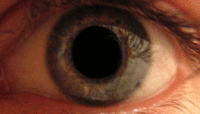
Photo from wikipedia
Summary During wakefulness, pupil diameter can reflect changes in attention, vigilance, and cortical states. How pupil size relates to cortical activity during sleep, however, remains unknown. Pupillometry during natural sleep… Click to show full abstract
Summary During wakefulness, pupil diameter can reflect changes in attention, vigilance, and cortical states. How pupil size relates to cortical activity during sleep, however, remains unknown. Pupillometry during natural sleep is inherently challenging since the eyelids are usually closed. Here, we present a novel head-fixed sleep paradigm in combination with infrared back-illumination pupillometry (iBip) allowing robust tracking of pupil diameter in sleeping mice. We found that pupil size can be used as a reliable indicator of sleep states and that cortical activity becomes tightly coupled to pupil size fluctuations during non-rapid eye movement (NREM) sleep. Pharmacological blocking experiments indicate that the observed pupil size changes during sleep are mediated via the parasympathetic system. We furthermore found that constrictions of the pupil during NREM episodes might play a protective role for stability of sleep depth. These findings reveal a fundamental relationship between cortical activity and pupil size, which has so far been hidden behind closed eyelids.
Journal Title: Current Biology
Year Published: 2018
Link to full text (if available)
Share on Social Media: Sign Up to like & get
recommendations!